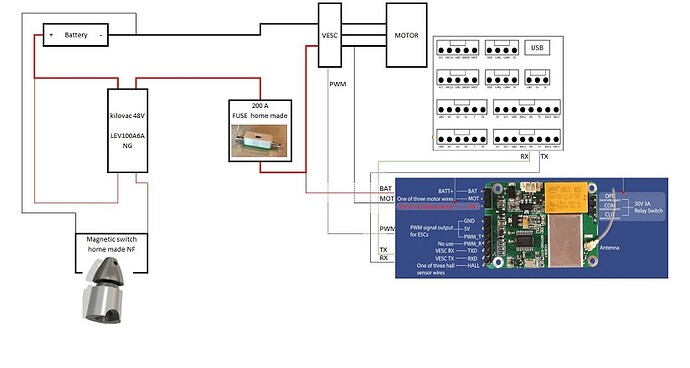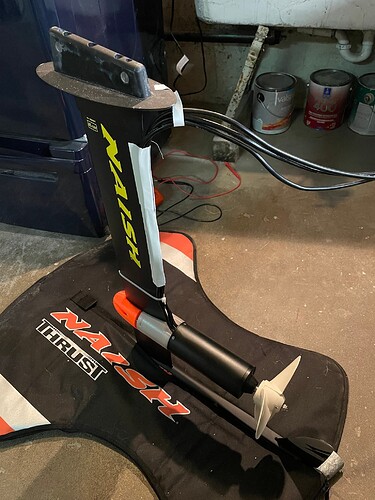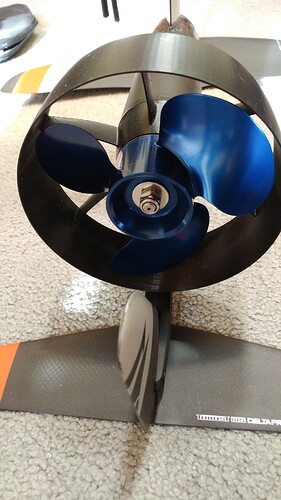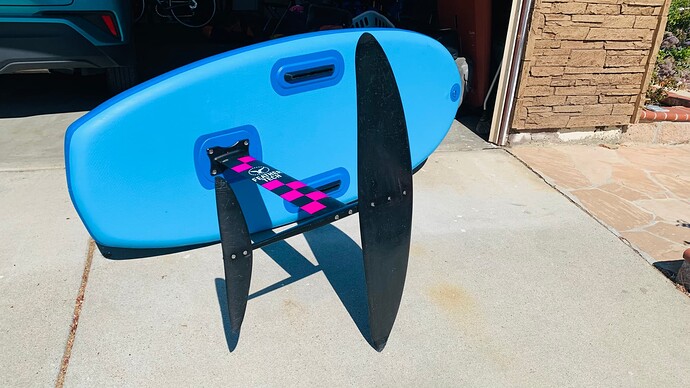To drill out the hole of the Flite prop, it is best to do it on a lathe. Machine a piece to hold it from the back, fix it with glue that can be removed, i.e. soft loctite. Then ream or lathe it to 12mm from the other side (front, side that faces towards the motor).
Yes I think your duct is a show stopper, the profile needs to be much more aquadynamic. You could try to adapt @pacificmeister’s parametric duct to fit your propeller. The gap between the duct and the propeller should be as small as possible, 0.5-1mm, therefore you need to choose the prop first.
I also started with a duct for security reasons but finally got rid of it (as many others as well). The sharp edges of the foil and mast are a bigger risk for injury.
@pacificmeister parametric duct: Parametric Propeller & Duct Design - Fusion 360 - #3 by pacificmeister
It looks like you have a lot of things wires, wire ties, and any thing else in the water. The drag will reduce your speed and those extra tenths will make a difference. If you can clean up your setup it may help. Good luck.
Your mast is right at the back of the board, but that’s probably just windsurf style - and made up for with a huuge long fuselage. Are you putting your weight back enough to allow take off? 15kmhr should be plenty for a big surf wing.
@wushbush Thanks, good point. Cleaned that up.
@sat_be Ordered a contactor too (this one: 200A 12,000W, 12kW NO Contactor | Electric Car Parts Co)
Going to try to run it from a 12V pack of batteries, but might not have enough current… In this case planning to to buy a 48V => 12V converter and power it from my main battery… anyone have this setup?
Once that’s setup and well tested, I’ll be more comfortable removing the duct.
@Jatem yes indeed, I bought the board from a windsurfer guy. I’ve been putting weight on front for now, since there’s a lot of weight on the back already. Got more tips about technique? Or links? Much appreciated.
Why not operate the contactor directly from the main battery, as is available 12-120V versions?
Mainly I’m concerned that my kill switch circuit would blow at 48V. I think it’s rated for 12V. Thoughts? Here’s the unit: https://www.amazon.com/gp/product/B00DH3QHBI
Don know the current draw at 48 V but should be rather limited just to operate the contactor. The kill switch is just a switch, its not limited to 12V, believe how much current it can handle is also related to voltage. This switch is rated for 5a 12V, cant imagine the contactor would use that much. would probably wire it directly from the main battery, obviously do some testing and measuring of the current to operate the contactor.
Edit. The specks says Maximum Coil Energy Draw: 15W. should be 0,31 amp at 48V?
@smus Hi, I think I saw a guy using a 48v cheap e-bike controller using the 12v rail, basically an improvised dc-dc concerter, I can’t tell exactly how but I think it’s possible, I need a converter too, it’s been such a long time and I still haven’t ordered one yet 
12V and 5V: DC-DC Buck Converter 12V-60V To 5V 12V Dual Output Step Down Voltage Regulator | eBay
12V only:
https://a.aliexpress.com/_m0M0W1T
Yers, the way @jeffM does it using a 48V 100A Kilovac relay, controlled by a 48V lanyard kill switch then drills the Flite 8mm prop to 12mm:
OSET MAGNETIC LANYARD KILL SWITCH - NORMALLY CLOSED
Hey Boris, any improvement yet ? Following as I am building my first efoil. Thanks
Welcome @alexander1
Quick update…
- I’ve cleaned up wires so that they produce less drag
- Installed this new kill switch which is purely mechanical, so no more fried SSRs and MOSFETs
- Removed the duct (YOLO)
I still haven’t had a chance to try this on the water tho – too busy with work and life and then it got cold here in Seattle. So basically either I need to start wearing a wet suit and taking days off, or wait for the weather to warm back up (~6mo).
My main question is safety, especially with no more duct. I think the new kill switch should be fine under load, but am a bit worried about the open circuit when the motor is killed by the kill switch, in terms of sparking and/or producing an undesirable short. Especially because… This is Water.
Safety aside, hopefully my modifications will give me enough juice to get up on the wing. If not, I’ll probably need to consider a new prop. If yes, I’ll buy a couple 20Ah batteries and replace my current 6.5Ah setup, triple my battery life and finally learn how to efoil ![]()
Those wires on the trailing edge are an absolute killer. It would probably be less shit if on the leading edge, and you could encase them in 3d printed covers, like seen on someone’s build here.
Best advice before you try to efoil, and even more so before you DIY efoil, is to learn basic foiling skills first. Take your setup behind a boat, a winch or an ebike somewhere and practice the feel for it, get to know its lift profile, get an idea of take off speed and stall speed, sweet spot, etc… And you can do all of this before your setup is ready.
Hi @smus, I think I have the same Naish Thrust foil as you, and thought I would need to cut off the vertical fin, as it might get in the way?
Thanks for the tip. I’ll move the wires to the front if I’m failing to get up still.
Interesting point. There might be some weird fluid dynamics issues there too.
How is yours build going? Looks like the FR prop? Did you manage to get flying?
Quick update. I have very little time because two young kids, but did manage to get back on the foil this summer.
Some tweaks WRT OP:
- Cleaned up the wires in the back (read: duct-taped)
- Removed the duct completely.
- Installed a much more reliable fully mechanical kill switch (see thread)
Results:
- I am no longer overheating, able to go ~2mi on one charge (just 6Ah)
- Went quite a bit faster, peaking at 21 km/h, still not planing!
Open questions:
- I still don’t have great analytics since telemetry is being sent to the remote, and there’s no logging for later as far as I can tell.
- Should I get a new prop? Am eyeing these props: Flipsky Motor – HighFly - WaterSports
- Maybe it’s my wingset? I really should be getting up at this speed. I’m definitely planing but also definitely not on the wing.
- Any tips for batteries? I was going to upgrade to a pair of these to go to 20Ah, but they’re out of stock again: https://hobbyking.com/en_us/turnigy-high-capacity-battery-20000mah-6s-12c-drone-lipo-pack-xt90.html?wrh_pdp=2
— At this speed, you should be on foil already. I suspect it could be the foil set you are using. I am using a large 2100 cm2 front wing and I could get on foil at around 10 - 12 mph.
Hmm. I’m using the 2019 Naish Thrust Windsurf foil. Just looked up its specs, seems substantially smaller surface area than yours (1220 cm^2).
Also expecting a FR prop soon (it shipped!), so will try to see if that makes a difference
I would assume the area is not the issue, more the shape of the wing - no idea what “Modified Delta Planform” means; but it’s clearly not saying “high lift” as for most of the others…
A lot of people are using the Gong curve MT which has only 1150cm² which flies aroun 16-18km/h.





